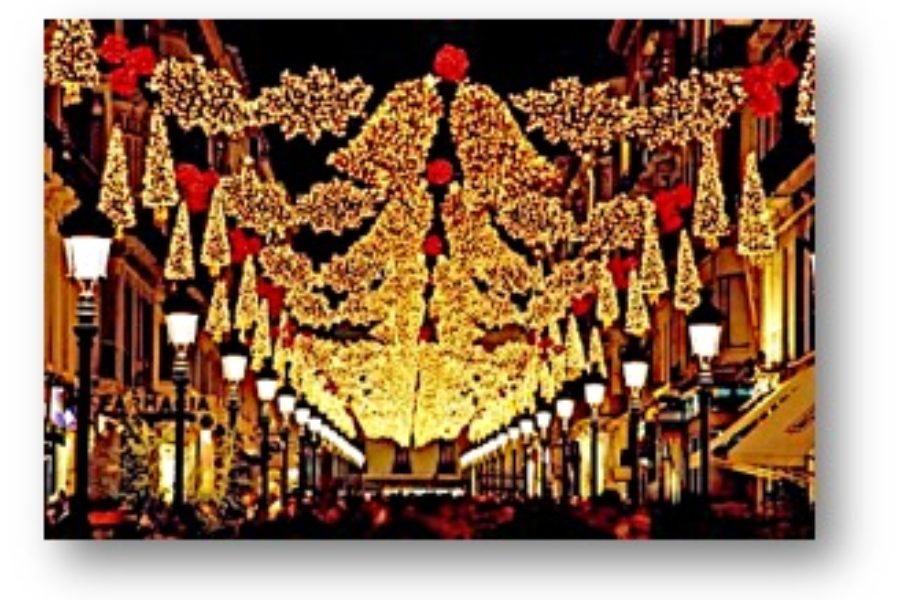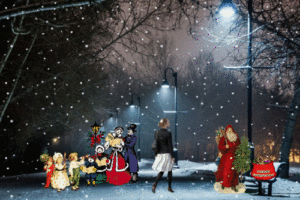Christmas on the Costa Blanca of Spain
by Darlene Foster
Christmas in Spain is a month-long party consisting of numerous fiestas, parades, fireworks, brass bands, markets, and food, lots of food. The first weekend in December is the official start of the Christmas season and it doesn´t take us long to get into the festive spirit. We live near Torrevieja where the season starts with a number of events celebrating the town’s Patronal Fiesta, dedicated to the patron saint, Inmaculada Concepción.
We start the celebrations by meeting a friend at The Casino for a drink and tapas on the first Saturday evening of the month. The Casino is not a place to gamble but rather a social club to meet friends, attend concerts and listen to lectures. It is elegant, comfortable and tastefully decorated for Christmas. It is also central to many of the events.
 Our appetite satisfied, we line the streets with the throng to watch a parade of marching bands and representatives from local organizations carrying flowers to the Inmaculada Church in the main town square for the traditional Floral Offering. Caught up in the excitement, we follow the parade to the square.
Our appetite satisfied, we line the streets with the throng to watch a parade of marching bands and representatives from local organizations carrying flowers to the Inmaculada Church in the main town square for the traditional Floral Offering. Caught up in the excitement, we follow the parade to the square.
Once at the church, each group is announced, and their floral offerings placed in a metal frame erected around the door of the church in which stands the patron saint. Most of the flowers are white and blue, the official colours of the town, with a few pinks and purples sprinkled in between. A Christmas market is held in the square to add to the festivities. There are so many people about it seems the entire town has turned out. The event is both exciting and moving.
We return the following day to view the beautiful flowers in the daylight, just as Sunday Mass is over. I am thrilled to see some of the Spanish people wearing traditional clothes as they come out of the church.
 A large Christmas Belen, a Bethlehem Nativity scene, is set up in the main square. This amazing display depicts scenes from the life of Jesus including day to day life, local businesses and of course a wonderful nativity. The details are incredible, from a little girl on a swing to hens in the yard. The Belen is up until January 7 for everyone to enjoy at no cost. Every time I walk around the display, I notice something new.
A large Christmas Belen, a Bethlehem Nativity scene, is set up in the main square. This amazing display depicts scenes from the life of Jesus including day to day life, local businesses and of course a wonderful nativity. The details are incredible, from a little girl on a swing to hens in the yard. The Belen is up until January 7 for everyone to enjoy at no cost. Every time I walk around the display, I notice something new.
The Fiesta continues all Sunday with music, fireworks, and entertainers. We stroll along the seafront and breathe in the inviting smells of the paella competition. Over 150 communities and groups take part in making their best paella. The Mayor and his entourage carry out the judging. They might be very full after sampling 150 paellas!
 Just as we are about to call it a day, we stumble upon a parade of unique paper mache giants and big heads outside the Casino. Delighted children and adults of all ages follow along. Monday is a holiday, Dia de la Inmaculada Concepcion, beginning with an early morning parade and ending with a solemn evening procession with the statue of the Inmaculada Concepion. The procession stops at the Casino for a fireworks display before returning back to the church. A perfect ending to a fabulous weekend of festivities to start the Christmas season.
Just as we are about to call it a day, we stumble upon a parade of unique paper mache giants and big heads outside the Casino. Delighted children and adults of all ages follow along. Monday is a holiday, Dia de la Inmaculada Concepcion, beginning with an early morning parade and ending with a solemn evening procession with the statue of the Inmaculada Concepion. The procession stops at the Casino for a fireworks display before returning back to the church. A perfect ending to a fabulous weekend of festivities to start the Christmas season.
 On Christmas Day everyone goes to the beach, including us. The beach is packed with families enjoying barbeques and picnics. Most of the men, women, children and even the dogs, are dressed in red and sporting holiday hats. We make our way through the crowd, past a group of Santas relaxing on beach chairs and enjoying a beer in the sun. Another Santa, with Mrs. Claus on his arm, strolls along the beach. A brass band entertains with familiar Christmas songs as well as a Spanish band featuring two amazing tenors. Everyone smiles and shouts Merry Christmas, Felize Navidad or greetings in their language! We are invited to share a table with some friendly folks. The lack of snow doesn´t make me feel any less Christmassy.
On Christmas Day everyone goes to the beach, including us. The beach is packed with families enjoying barbeques and picnics. Most of the men, women, children and even the dogs, are dressed in red and sporting holiday hats. We make our way through the crowd, past a group of Santas relaxing on beach chairs and enjoying a beer in the sun. Another Santa, with Mrs. Claus on his arm, strolls along the beach. A brass band entertains with familiar Christmas songs as well as a Spanish band featuring two amazing tenors. Everyone smiles and shouts Merry Christmas, Felize Navidad or greetings in their language! We are invited to share a table with some friendly folks. The lack of snow doesn´t make me feel any less Christmassy.
In Spain, the most important date in the Christmas season is not December 25. It is January 6, Epiphany, the day Three Kings from the east brought gifts to the infant Jesus. Fiesta de Los Tres Reyes Magos (Three Kings Day) starts on January 5 when the Three Wise Men arrive and parade through the streets handing out candies to all the children eagerly waiting. The parade ends at a church where the kings become part of a human nativity scene. That night the children put out their shoes and, in the morning, if they have been good all year, they find them filled with gifts from the Magi. They leave out treats for the kings and water for the camels. Like children in North America do for Santa Claus and his reindeer.
 We have the pleasure of experiencing this event. We wait patiently as The Kings; Gaspar, representing frankincense, Melchior, representing gold, and Balthazar, representing myrrh, arrive by boat in the coastal town of Torrevieja. They greet us in Spanish and English, waving as they pass by to join the parade.
We have the pleasure of experiencing this event. We wait patiently as The Kings; Gaspar, representing frankincense, Melchior, representing gold, and Balthazar, representing myrrh, arrive by boat in the coastal town of Torrevieja. They greet us in Spanish and English, waving as they pass by to join the parade.
Along with their entourage, the kings participate in the traditional Epiphany parade that winds its way through the town. It is quite a spectacle with a variety of participants including Mary, Joseph, baby Jesus, Roman centurions, Egyptians, dancers, decorated riders, royal pages and a menagerie of animals. Excited children line the streets holding out bags for the many candies they receive from the participants in the parade, including the Three Kings. We enjoy the pageantry and spirit of the evening. Some of the children even share their sweets with us.
There are parties and family dinners on January 6th. We attend a King´s Day party around the pool and are treated to traditional King´s Day cake called Roscón. A sweet, large donut-shaped bread covered in glazed cherries and sugar hides a plastic toy buried inside. The person who finds the toy is guaranteed good luck for the next year. We don´t find a toy but enjoy the cake and the company. Another wonderful Spanish tradition to enjoy.
The Spanish people know how to celebrate. Everything is centred on family, community, and religion. It is the true meaning of Christmas and I love it.
 Darlene Foster, originally from Alberta, Canada, is a dedicated writer and traveler. She is the author of the Amanda Travels series featuring Amanda, a spunky young girl who loves to travel to interesting places such as the United Arab Emirates, Spain, England, New Mexico, and Eastern Europe, where she always has an adventure. Darlene divides her time between the west coast of Canada and the Costa Blanca of Spain with her husband and entertaining rescue dog, Dot.
Darlene Foster, originally from Alberta, Canada, is a dedicated writer and traveler. She is the author of the Amanda Travels series featuring Amanda, a spunky young girl who loves to travel to interesting places such as the United Arab Emirates, Spain, England, New Mexico, and Eastern Europe, where she always has an adventure. Darlene divides her time between the west coast of Canada and the Costa Blanca of Spain with her husband and entertaining rescue dog, Dot.
Learn more about Darlene and her books on her website www.darlenefoster.ca
Feature Image from taylorwimpeyspain.com




13 Comments
Leave your reply.